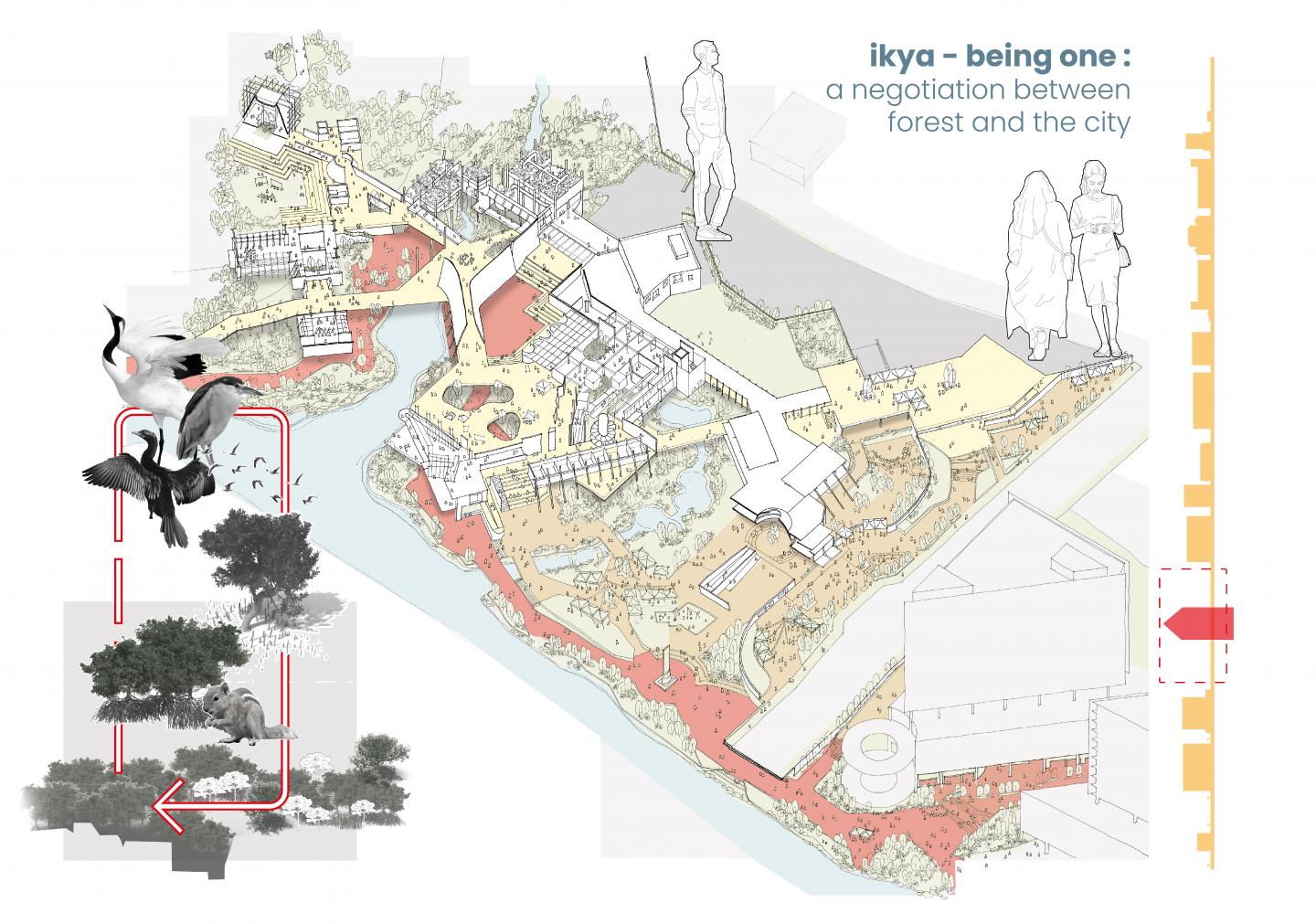"IKYA: A Negotiation Between City and Forest"
In the face of rapid urbanization, Kochi has transformed into a congested conglomerate of construction. However, at its core lies the Mangalavanam Bird Sanctuary, a pristine forest spanning 2.7 hectares, providing a striking contrast to the surrounding cityscape. A palpable tension exists between these two spaces: the city's relentless expansion attempts to breach the boundaries of the forest, while the forest endeavours to safeguard its territory.
This project challenges the necessity of such a stark divide and strives to discover a more harmonious equilibrium between the forest and the city. It seeks to alleviate the strain on their boundaries and negotiate a mutually beneficial arrangement.
To achieve this goal, the project considers architecture from three perspectives.
Firstly, architecture's role in a broader context is examined. Every intervention exerts influence on its surroundings. Thus, the question arises: Can architecture seamlessly integrate into the existing urban fabric? In order to navigate this negotiation, one must comprehend the city's needs and the ecological dynamics of the region. Consequently, a thorough analysis of the Marine Drive region was conducted, identifying its requirements, potential, and opportunities. It was discerned that the city necessitates more open green spaces where individuals can pause, connect with one another, and embrace nature—an inclusive recreational environment accessible to all.
Moreover, amidst the ongoing pandemic, integrating these aspects creates a safe and healthy space for people to venture out and interact. Implementing pedestrian paths, cycling tracks, open gyms, and other interactive areas fosters a healthier lifestyle.
Additionally, the city requires a sewage treatment facility, which is typically isolated from urban spaces. With no designated area for this essential service within the city, the project and its site possess the potential to integrate this facility alongside residential areas. Drawing inspiration from the "living machine" technology—an innovative approach to sewage treatment—the service can be seamlessly incorporated in an intriguing manner. This not only presents a challenge to the project but also offers an opportunity to reimagine a city service as an informative or intriguing space, thereby dismantling the social stigma often associated with such facilities.
At a more localized level, one must also listen to the site's natural cycles—the delicate balance that sustains every element within the ecosystem. Inconsiderate interventions can strain this harmony; hence, it is the architect's responsibility to plan in a manner that minimizes negative impacts. As architects, we must learn to attune ourselves to the stories nature tries to convey and act accordingly. The site, a 7-acre plot adjacent to the Mangalavanam Bird Sanctuary, is a wetland that constantly undergoes transformation due to indiscriminate large-scale projects. It is a sensitive land with a diverse range of flora and fauna. The project aims to rejuvenate the wetlands and gradually create an environment that allows birds, animals, and humans to coexist harmoniously.
Finally, architecture is conceived as an experience for all inhabitants within the context, and great care is taken to understand how the built and unbuilt elements can heighten the sensory perception of the space's users. Colours, volumes, landmarks, sounds, and activity hubs are employed as tools to guide and inspire people to explore different areas. By capturing the temporal characteristics of the site through multifunctional spaces and embracing its seasonal attributes, the visit becomes a captivating experience.
Viewed through these lenses, architecture acts as a bridge between the contrasting forces of nature and the city. By blurring the boundaries between architecture and its context, as well as architecture and ecology, this process brings about a holistic, seamless, and interconnected experience.
2022
Project Location: Marine Drive, Kerala, India
Area: 13650 sqm
Mixed-use urban infrastructure
Author: Adith Soney
Instructor: Prof. Alok Dinesh
University: College of Engineering Trivandrum










